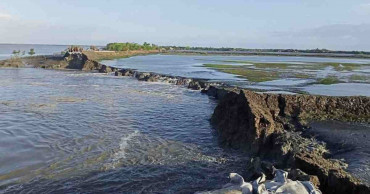Flood in Bangladesh
Lalmonirhat flood: Teesta water recedes, miseries mount
Although water levels in the Teesta River have started to recede the suffering of thousands of flood-hit people continues as waterborne diseases spread in Lalmonirhat district .
The water level of the Teesta started to drop below the danger mark on Friday morning bringing slight relief but various waterborne diseases are on the rise due to the scarcity of drinking water, further exacerbating the suffering of flood victims.
The Water Development Board recorded the Teesta’s water level at 51.92 metres at the Dalia Barrage point in Hatibandha upazila—23 centimeters below the danger mark around 2 pm on Friday.
According to the Flood Forecasting and Warning Center, the river began swelling from the night of August 11 due to continuous rainfall and onrush of water from the upstream.
Floodwaters submerged large portions of Lalmonirhat Sadar, Patgram, Hatibandha, Kaliganj, and Aditmari upazilas and low-lying areas along the riverbanks, leaving nearly 10,000 people stranded.
The worst-hit areas are Dahagram in Patgram upazila, Goddimari, Dowani, Choyani, Saniajan, Singimari, Sindurna, Holdibari and Dowabari in Hatibandha upazila, Bhotmari, Shoilmari and Nohali in Kaliganj upazila, Mahishkhocha, Gobordhan and Bahadurpara in Aditmari upazila and Khuniagachh, Kulaghat, Mogolhat, Rajpur, Borobari and Gokunda unions in Sadar upazila of the district.
Over 40,000 stranded in 5 districts as Teesta flows above danger mark
Families faced severe hardship as floodwaters entered homes and women were cooking once a day on makeshift stoves inside their houses or on embankments and roads.
Many villagers sheltered their cattle under polythene tents on high grounds.
Salma Begum, a resident of Gaddimari village in Hatibandha upazila said, "The roads have been submerged. There is water from knee to waist in every house in our village. Cooking, eating, living and using the toilet have all become difficult. We couldn't sleep at night. I am in panic with the children, wondering when someone will fall into the water."
Executive Engineer of the Water Development Board in Lalmonirhat, Sunil Kumar, said, “ Now the Teesta water levels have dropped below the danger mark but it will take some time for the situation to improve. Residents are being urged to remain alert.”
Teesta swells above danger mark again; low-lying areas flooded in Nilphamari
As of Friday afternoon (August 15), Teesta’s water was flowing 23 cm below the danger level.
"We are monitoring the situation round the clock," he added.
4 months ago
Eight villages in Feni flooded as embankment collapses
Eight villages in Phulgazi upazila of Feni district have been flooded as the flood control embankment along the Muhuri River collapsed due to the onrush of water from upstream and heavy rainfall.
The local Weather Observatory centre has recorded 152 mm of rainfall in the past 24 hours till Monday afternoon.
Monir Ahmed, deputy assistant engineer of Feni Water Development Board, said Muhuri river was flowing 100 cm above its danger level at 9 am on Monday while 20 points of the dyke along Muhuri-Kahua-Silonia rivers are at risk of collapse.
Torrential rain causes flood in Bandarban; Around 30,000 people marooned
Already 20 meters of an embankment along the Muhuri river at Uttar Daulatpur and Uttar Baraia point in Phulgazi upazila collapsed on Monday, inundating the low-lying areas including Uttar Baraia, Bijoypur, Kismat Bijoypur, Dakkhin Baraia, Jagatpur, Uttar Daulatpur, Dakkhin Daulatpur, Banikpara villages.
Enamul Haque, a resident of Uttar Baraia, said 10 meters of the embankment along the Muhuri river in the village collapsed around 4:30 am due to the heavy rainfall activities for the last several days, causing immense suffering to the residents.
Beijing records heaviest rainfall in at least 140 years, causing severe flooding and 21 deaths
Rahima Begum, another resident of the village, said “There is no scope to cook as the river water entered into our houses, forcing us to reel under the water.”
Anwar Hossain, a resident of the village said negligence on the part of the local Water Development Board is the main reason behind the flood every year.
Tania Bhuiya, Phulgazi Upazila Nirbahi Officer (UNO), said eight villages have been flooded, leaving 200 families marooned.
Floods around Chinese capital kill at least 20, leave 27 missing as thousands evacuated
120 hectares of Aman and 10 hectares of Aman seed beds were damaged in the flash flood, said KHM Manjurul Islam, deputy assistant agriculture officer of Phulgazi upazila. Besides, all the vegetable crops land were submerged by the river water and the extent of the loss caused by the flood will be fixed after the receding of water, he said.
Contacted, Arifur Rahman Bhuiya, deputy divisional engineer of Feni Water Development Board, said the work for building a sustainable dam and repair work, involving Tk 731 crore will be started soon.
Deputy Commissioner Shahina Akter, said the local administration is regularly monitoring the flood-affected areas and Tk 2 lakh cash and 3.5 metric tonnes of rice has been allocated for the people in the flood-hit areas.
2 years ago
Flood situation in Netrokona’s low-lying areas may improve in 24 hours: FFWC
Flood Forecasting and Warning Centre (FFWC) predicted that the flood situation in low-lying areas of Netrokona districts may improve in 24 hours.
FFWC, in its regular bulletin, said Brahmaputra River remains unchanged but Jamuna river water is in a rising trend, which may continue in 24 hours starting from 9 am on Thursday (July 06, 2023).
Read: Rise in Teesta water may cause short-term flood in Lalmonirhat, Nilphamari in 24 hours: FFWC warns
Water in the Ganga-Padma Rivers is in a rising trend, which may continue in 72hours, it reads.
Besides, major rivers in the northeastern region of the country are in a falling trend except Khowai, Monu and Dhalai, which may continue in 48 hours, the bulletin said.
Read more: Better flood management: China offers assistance for dredging rivers in Bangladesh
2 years ago
Rise in Teesta water may cause short-term flood in Lalmonirhat, Nilphamari in 24 hours: FFWC warns
Water in the Teesta river may cross the danger level at Dalia point over 24 hours, causing a short-term flood in the low-lying areas of Lalmonirhat and Nilphamari districts.
Flood Forecasting and Warning Centre (FFWC), in its regular bulletin, said the Brahmaputra-Jamuna and the Ganges-Padma rivers are in a rising trend, which may continue over 48 hours and water in the Dhalai river may cross danger level at Kamalganj point for a short period over 24 hours, starting from 9 am on today (July 05, 2023).
All gates of Teesta Barrage opened due to increase in water level
Besides, major rivers in the northeastern region of the country are in a falling trend except Khowai, Someswari and Dhalai, which may continue over 48 hours, the bulletin said.
Flood submerges 10 villages in Sunamganj, rain continues
The ongoing flood situation in Sunamganj and Netrokona districts may remain unchanged in 24 hours, it said.
Heavy rains may trigger short-term flood in Sylhet, Sunamganj
2 years ago
Low-lying areas in Sunamganj inundated; 322 mm rainfall recorded in 24 hrs
Low-lying areas in Sunamganj district including the town have been inundated due to incessant rains for the last four days till Sunday morning and onrush of upstream water.
Water Development Board recorded the country’s highest 322 mm of rainfall in 24 hours till Sunday morning, said its executive engineer Mamun Hawladar.A vast tract of low-lying areas including Shahebbari ghat, Kazir Point, Nabinagar, Hasannagar and Natunpara in the district town were submerged.Besides, the Surma was flowing 6 cm above its danger level while the water levels of Jadukata, Khasiamara, Chela, Monai, Someshwari rivers are also in rising trend.Roads in different areas were damaged due to flood while communication on Madhyanagar-Mahishkhola remained snapped.
Heavy rains may trigger short-term flood in Sylhet, Sunamganj“If the rainfall continues in the district it will damage more roads, " said Jamalganj Upazila Chairman Iqbal Al Azad.Salma Parveen, Sadar Upazila Nirbahi Officer (UNO), said the flood water entered many houses due to waterlogging.
Flooding displaces tens of thousands and kills 1 as heavy monsoon rains batter Indian villagesDeputy Commissioner Didar Alam Maksud Chwodhury urged the people of the flood-hit areas to take shelter in the educational institutions if flood water entered their houses.Meanwhile, the Flood Forecasting and Warning Center of the Bangladesh Water Development Board predicted that the North-Eastern and adjoining upstream region of the country may experience short-term flood due to heavy rainfall in 48 hours since Sunday (July 02, 2023) morning.Some rivers of this region including Surma, Old Surma, Sarigowain, Khowai, Jadukata, Someswari, Bhogai-Kangsha may rise rapidly and cause short-term flood in the adjoining low-lying areas as there is a chance of heavy to very heavy rainfall in the region during the period, it said.
Flood crisis grips Kurigram: thousands trapped, shortage of food-water intensifiesThe Brahmaputra-Jamuna and the Padma rivers are in steady state, while the Ganges River is in rising trend, which may continue in next 48 hours.All the major rivers in the North-Eastern region of the country are in rising trend.Due to the chance of heavy rainfall in the adjoining upstream, the Teesta, the Dharala and the Dudhkumar rivers in the Northern region may rise rapidly at times in the next 48 hours.Teesta river may cross danger level at Dalia point in the next 24 hours, said FFWC.Last year, the residents of Sylhet district experienced a devastating flood as 70 percent of the district went under floodwater while 10,000 dwelling houses were damaged, causing immense sufferings to thousands of people.
2 years ago
Flood death toll rises to 140
The death toll from this season's floods in the country rose to 140 with another death in Sylhet in 24 hours till Thursday morning.
The total deaths were recorded from May 17 to August 18, according to the Directorate General of Health Services (DGHS).
Of the deceased, 79 were from Sylhet, 43 from Mymensingh, 17 from Rangpur and one from Dhaka division.
Also read: Flood death toll rises to 139
One hundred and eight people drowned in floodwaters, 19 died by lightning strikes, three from snake bites, one from diarrhoea, and nine others due to other reasons.
Around 33,994 people were hit by floods during the same period.
Thirty-seven upazilas, including 33 in Sylhet, three in Rangpur and one in Chattogram divisions were affected by floods.
Also read: Vast areas in Paikgachha of Khulna flooded as dam collapses
Sylhet, Sunamganj and Moulvibazar were the worst-hit districts, with 13, 11 and five upazilas affected by floods respectively.
3 years ago
Embankment goes into riverbed in Khulna
An embankment built to prevent erosion by the Kopotakkho river in Charmukha area under Khulna’s Koyra upazila has been ruined due to increased water pressure.
The embankment started to break on Sunday noon. The locals are fearing that vast areas will be inundated due to high tide if the embankment isn’t repaired in due time.
According to Osman Gani, a member of the local ward, a road on one side of the Charmukha canal went into the riverbed around 4:00am.
“The road was in a precarious condition for a long time. Many other roads and houses have started to go extinct due to increased flow of the Kopotakkho river. We’re trying to repair the dam on our own initiative. Large parts of the area will be inundated if we can’t repair the dam within the next one to two hours,” Osman said.
Read: Onrush of upstream water threatens Chandpur town protection embankment
3 years ago
Implement flood rehabilitation programmes through local organisations: CSOs
Civil society organisations (CSOs) Monday demanded that post-flood rehabilitation programmes, especially in the haor regions, be implemented through local organisations.
"In any disaster, the local people and organisations are the first to stand beside the people hit by any disaster. So, the capacity of local organisations should be increased; the post-flood rehabilitation activities in the haor regions must be implemented by them," they said at an online press conference organised by BDCSO process, a network of about 700 national and local CSOs and NGOs.
Abdul Karim Kim, general secretary of BDCSO Sylhet division, presided over the press conference moderated by Rezaul Karim Chowdhury, national coordinator of BDCSO Process.
BDCSO Sylhet Division President Tofazzal Sohel said several organisations, including the United Nations, had surveyed the impact of the recent floods. "In addition to assessing the damage, they also verified the need for post-flood rehabilitation."
Also Read: Flood in Bangladesh: Death toll stands at 107
"It is really good if international organisations stand beside the people along with the government. But we are, as always, inspired by the role of local people and local organisations during floods. Recognising this role, we believe, the UN agencies and INGOs should fund the implementation of post-flood rehabilitation programmes through local organisations as they understand the needs of local people best, and they can be more effective in implementing the programmes."
Rezaul said the role of international organisations is important, but they should limit their activities to fundraising, technical assistance and monitoring. "Field-level activities should be implemented by local organisations and the whole process should be coordinated by the government."
AWARD Executive Director Abul Kalam Azad, ADAB Sylhet Division Coordinator Babul Akhter, ADAB Sylhet District President ATM Badrul Islam, Shahjalal University of Science and Technology Professor Zahirul Haque Shakil, and Disaster expert and writer Gowhar Naeem Wara also spoke.
Azad said: "We have been working with the local people for a long time. So, if any programme is implemented through us, it is more likely to be sustainable."
Zahirul said: "I saw a person spending Tk40,000 to get relief of Tk10,000 taka. He could get assistance of Tk50,000, had the relief been distributed through a local organisation."
Wara said it is now very important to determine what is needed for local rehabilitation. "This demand needs to be verified by the local agencies working in the field."
3 years ago
Floods wash away crops and hopes in Kurigram
Farmers in Kurigram have been hugely hit, with the recent floods wrecking havoc on their crops.
Agriculture is one of the mainstays of Bangladesh's booming economy, but the devastation to crops in the northern district has put the livelihoods of many farmers on the brink.
In fact, the losses in the agriculture sector caused by the floods in Kurigram has been estimated at a whopping Tk 127.54 crore, according to the Department of Agricultural Extension (DAE).
According to the DAE, a total of 80,035 cultivators have been affected by the floods, with 15,851 hectares of cropland in the district being partially or fully destroyed in the natural calamity.
This season, the farmers of the district cultivated 34,310 hectares of agricultural land. But due to the flash floods and heavy downpour, around 15,851 hectares have been inundated. Of these, 7,351 hectares have been damaged fully during the fortnight-long floods.
Read Also: Thousands still marooned by floods in Savar
Apart from this, around 8,427 hectares of cropland have been damaged partially by the floodwaters. As a result, the production of a total of 35,055 metric tonnes of crops has been affected, which is 25.57% of the total crops.
The Aush paddy and jute have been affected the most, followed by vegetables.
Floodwaters have damaged 9,521 hectares of cultivated jute land of a total of 16,577 hectares, 3,580 hectares of Aush paddy of a total of 8,480 hectares, and 1,161 hectares of vegetables of 4,034 hectares of cultivated land in Kurigram.
Read Also: Food, work shortage hits Kurigram flood victims hard
The damaged crops in the district include Aman seedbed, jute, Aush paddy, sesame, vegetables, peanuts, banana, corn, chili, ginger, turmeric, onion, sugarcane and lentil.
Shamsul Alam, a vegetable grower of Chararpar village under Kurigram sadar upazila, said, “I invested Tk 50,000 from my own pocket and borrowed Tk 30,000 from an NGO. Also, I borrowed Tk 20,000 from a local lender at a high rate of interest. I have suffered huge losses."
Another farmer, Jabbar Ali of the same village, said, “We hoped to make big bucks this year. But the flash floods washed away our dreams.”
Contacted, Md Abdur Rashid, deputy director of Kurigram DEA, said, “We have informed the higher authorities after estimating the losses. The affected farmers will be brought under incentive packages."
"We have already received an allocation to bring 7,000 farmers under incentives which will help them recover some amount of losses," he added.
3 years ago
Receding flood waters reveal disastrous damage in Sylhet
As the waters started receding following Sylhet division's worst flood in living memory, the disastrous damage it inflicted also became evident, along with the challenge any recovery effort will face in the days ahead.
The death toll from the third flash flood of the year in Sylhet reached 52 till Sunday morning (from May 17), according to the Directorate General of Health Services (DGHS), but this is almost certainly an underestimate, with local sources claiming the toll to be much higher. Many areas haven't even been accessed, where the authorities have no idea of casualties.
According to Sylhet District administration, around 22 lakh people from four lakh families are bearing the brunt of this terrible disaster while 80 percent of the area still remains under water as of Sunday.
“Part of Sylhet City Corporation, all the 13 upazilas and five municipalities and 94 unions were affected in the district. The exact number of people facing the damages will be 21,87,232 (21 lakh 87 thousand 232)of 4,16,819 families (4 lakh 16 thousand 819),” said Ahsanul Alam, Assistant Commissioner of District Administration.
He said 22,450 houses and 28,945 hectares of cropland have been damaged according to official estimation so far.
However, locals are claiming the damage is vaster and the recovery will be long.
Also read: Flood situation worsens in parts of Sylhet
Bearing the brunt
Tara Mia, 70, from Janigaon village, has not seen such a terrible flood in his entire life. “On June 16, when all of a sudden water started entering my house I took shelter near a high area beside Sylhet-Sunamganj highway and remained there since. None cares about us though, people come and speed away with their vehicles as we sit helplessly beside the road,” he said.
Khushbu Begum, 60, from the same village said, ”Don’t know how we will get back to our homes after flood water lowers as it is filled with soil now.”
Husnahar Banu, 35, who took shelter in a ramshackle cottage beside the highway with her six children, said,”We took refuge here 14 days ago and are not sure how many days we will need to spend on the roads. There is still water inside the home that we left.”
Fifty-five-year-old Kahar Mia was more worried about his cattle as some of them had already washed away. “We can survive by eating flattened or parched rice but the helpless animals might die without their food,” he said.
Akkas Ali, from Jaikar Kandi village in Kandigaon union, returned home from the shelter center on Saturday evening and broke down in tears as nothing but the foundation remained.
“The floodwater took away everything but the clothes on our bodies. We are eating the relief provided by people. How will we build everything back now?” he wondered aloud as he was unsure how to bring back his family from the shelter as there is no home.
Tahera Begum from Moiar Char village said,”For five days I took shelter in Badaghat High School and as I returned home found the toilet was broken and everything in the house was damaged. Repairing everything is the biggest challenge for everyone as the flood has snatched our income sources too."
3 years ago








.jpg)






